#cedrela
Explore tagged Tumblr posts
Text
Frédéric Manfrin - Ballades parisiennes - Le cedrela
Parmi les merveilles du printemps,Quand les arbres se réveillentLa nature se pare de vert éclatant.Mais il est un original, un sans-pareil :Le cedrela.Jeunes feuilles rose bonbon,Sur le ciel de Paris,Comme un air de Japon,Instant de magie.

View On WordPress
0 notes
Text


a lil commission of Cedrela for Kuro49 on fr! extremely fun ive never drawn any of these genes before, and i this is my like 4th time drawing this hood and i think it looks pretty good this time!
31 notes
·
View notes
Text
Hail Caesar, Those About to be Dispossessed Salute You!
By Tade Ipadeola
When colonists first arrived in Africa, they convinced themselves that Africans had no real sense or conception of ownership. Also, they came from their home regions with a notion that possession was 99% of ownership, anyhow, and began to act on these profound errors in various ways. They raided, maimed and killed to name landmarks and even countries after themselves – Lagos, Victoria Falls, Lavington Hills, Rhodesia, Victoria Island, Escravos, and Johannesburg etc. When they found an African name cute enough, they thought it wiser not to change it because, well, gifting Kilimanjaro to your favourite nephew in Germany was a cooler thing to do than renaming the mountain. Everyone knows that it would be a tough assignment to come up with an English name surpassing Kilimanjaro. You see, a word as intriguing as, say, “chimpanzee” has more primal and exotic ring to it than any variorum of the word “ape”.
Governor Makinde of Oyo State of Nigeria has been acting very much like the colonizers over those who are supposed to be his own people. Whereas one can make up a case for the Arab or the European occupier – they laboured under baffling ignorance regarding the humanity of dark skinned Africans, for the most part, but no such excuse(s) can be made for a Seyi Makinde whose mantra to power is “Omi Tuntun.” He, of all people, should know better than to join Caesar's circus. He should act with a consciousness of his people’s history and their common heritage. So far, and with alarming intensity since his second term in office began, he has done the precise opposite of what a thoughtful civilian governor should do, with devastating consequences for the environment and society at large.
Like a dark and malevolent rumour, word began to spread in Oyo State that the Trans Amusement Park would be sold to private estate developers, along with the Agodi Ogunpa Forest Reserve and Gardens. The rumour was received with some consternation by citizens. Then followed the implementation of a 1 kilometer setback (500 meters on either roadside) for a circular ring road for Ibadan, the State Capital. The interesting thing was that even under the Federal Highway Act, the setback on either side of a Federal Trunk A road is precisely 47.5 meters. Up until the present, the people of Oyo State do not have a replacement for the Trans Amusement Park, thoughtfully provided by the Bola Ige administration, now taken away from them by Caesar Omi Tuntun and his cronies.
Out of the blues, Caesar went public with the grandiose idea for a 3,149 hectare Ilu Tuntun Business District. This Caesar, whose public rating on assumption of office as governor ranked as high as that of any popular governor of Oyo State, began to sink rapidly in the public estimation of Ọ̀yọ́ citizens, with the State Secretariat at Agodi hosting mammoth protests by citizens whose ancestral land holdings were being systematically stripped by vested commercial interests citing support from the governor’s office.
Take the Baywood Estate, so called, which is planned to occupy the carefully conceived and executed 70 acres of 70-year-old Agodi Ogunpa Forest Reserve and gene bank. All 70 acres have been stripped utterly bare, with the topsoil gone and the subsoil exposed today. Over 25 rare species of trees from as far away as Australia, India, Burma and Sri Lanka are now gone, perhaps forever. Eucalyptus torelliana, Terminalia superba, Terminalia ivorensis, Terminalia catapa, Nauclea diderichii, Ficus exaperata, Tectona grandis, Gmelina arborea, Khaya grandifolia, Ceiba pentandra, Milicia excels, Anthocaphalus cadamba, Alstonia bonnie, Albizzia labbeck, Triplichyton selerexylon, Bombax buonopozense, Cedrela odorata, Morus alba, Funtumia elastica, Albizia zygia, Antiarii toxicaria, Celtis zenkeri, Cola gigantea, Cordia millenii and Mansonia altissima among others, all gone because Baywood Infrastructure Limited and Caesar thought it wiser to wipe out this enormously rich bequest of the Western Region Government to future citizens of the region. The elders thought that by investing huge resources in this forest reserve and making a Gazette for its preservation, there is thereby a legal guarantee that it would remain a gift in perpetuity to mankind as well as reliable protection for the Ogunpa water basin.
Caesar and his two collaborator-directors of the Baywood Infrastructure Limited, one Abiodun Adebayo Otunola and another Favour Nene Otunola ended that grand vision of the forefathers without as much as an inventory of what they took from the commonwealth or where they took it or how much for the public to know. Although conscientious citizens brought the legal status of the forest reserve to Caesar’s notice, he and his accomplices disregarded the notification and today the bulldozers are in Agodi, making the open wound on the face of Oyo State wider, siting up Ogunpa and altering the hydrostatic balance of the basin.
By September of 2024, downstream from the Agodi Ogunpa Forest reserve, just months after Baywood began its thoroughgoing destruction of Agodi Ogunpa Forests, floods killed 2 persons and the National Emergency Management Agency declared 2 persons more missing. These horrendous developments just downstream from the violated Agodi Ogunpa basin, were avoidable tragedies. The world is hereby put on notice not to participate in this ongoing crime against the citizens of Oyo State and their environment by way of any ‘investments’. Caesar’s cynicism in setting up a so-called Flood Management Agency also reeks of Orwellian cheek https://von.gov.ng/oyo-state-set-to-establish-flood-management-agency/ because there is no one more active in mismanaging the flood situation than Caesar himself.
But by far the most insidious development yet is the so-called Ilu Tuntun Business District. The Punch Newspapers and other media sources report that Caesar and his foot soldiers have come up with a design to do what the Yoruba describe as hosting Àwé to a treat with Àwé’s funds. Fífi owó Àwé ṣ’Àwe lálejò - https://punchng.com/oyo-to-establish-business-district-in-ibadan/
In this grand plan, Caesar takes some 3,149 hectares from the people and resettles the dispossessed on 598.613 hectares out of the main snatch. To put a veneer of legitimacy on this heist, Caesar and his minions rustled up a ‘stakeholder meeting’ with the people who are to be affected by the model business district which is the largest ever in the world. At present, Midtown Manhattan, with some 288 hectares of land is the largest business district in the whole wide world. The stakeholder meeting is a study in how internal colonization works. On the face of it, the 3,149 hectares over which Caesar summoned the ‘stakeholders’ has the poor and the powerful in its dragnet. There was no meeting, only a simulacrum of one. The poor were present but the powerful Railway Corporation of Nigeria, whose facilities and lands Caesar also ostensibly acquired, were notably absent. By Monday, the 4th of November 2024, minions from Caesar’s Agodi Secretariat had begun marking houses of the poor for demolition all over the ‘Ilu Tuntun Business District’ but not one mark was placed on any property of the Railway Corporation. It appears that even rabid dogs observe boundaries when approaching lion territory. The entire charade showcases the mind of an internal colonialist at work, the mind of Caesar bringing civilization to the brutes, or so it seems.
The Akinyele Local Government Chairman who spoke for Caesar rather than the citizens should know that ‘investors’, foreign and domestic, have been put on notice that Caesar cannot give what he does not own. In a democracy, every town, village and hamlet, every land holder has a say. Those planning to situate their businesses in a contested, ancestral space should know that people persuaded against their will remain of the same opinion still. To reiterate a trite point, Oyo State does not have funds enough to relocate the ancestors of Akinyele from the earth that holds their cherished remains. Ọ̀yọ́ is currently indebted in billions.
Africans have fought colonizers to have their own returned to rest in native soil under African skies for a reason and Caesar may just have to humble himself, get off his high horse, and respect the people and the ancestors. The ties that bind may be invisible but they are nonetheless real. It is foolish, to say the least, to think that the poor can be exploited together with their honoured dead by mercantilist tinkerers without unintended consequences.
Here we have oríkì and we have orílẹ̀. If any governor claims to be one of us and not a Caesar of a circus, that person must know what these mean. The subject of ancestral African land and the African environment and heritage will become even more central the more we negotiate modernity, industrialization, and change. The very importance of these subjects necessitates a thoughtful approach rather than whim and diktat. May God help the wolf after whom the dogs have ceased to bark.
Tade Ipadeola, lawyer, retired civil servant and nationally decorated poet, writes from Ibadan.
0 notes
Text
Lista de 100 Espécies de Árvores Nativas Brasileiras para Reflorestamento
rientações sobre Plantio e Adubação para um Crescimento Saudável

Segue uma lista de 100 espécies de árvores nativas do Brasil, adequadas para projetos de reflorestamento, juntamente com orientações detalhadas sobre como plantar e adubar para garantir um crescimento saudável.
*Contato:
-Telefone: [Paulo ]
- E-mail: [[email protected]]
- Endereço:[Limeira/SP]
Lista de Mudas de Árvores Nativas e Urbanas para Reflorestamento
Ipê Amarelo (Handroanthus albus)
Araucária (Araucaria angustifolia)
Jequitibá-Rosa (Cariniana legalis)
Pau-Brasil (Paubrasilia echinata)
Pitangueira (Eugenia uniflora)
Jabuticabeira (Plinia cauliflora)
Aroeira (Schinus terebinthifolia)
Embaúba (Cecropia pachystachya)
Sibipiruna (Caesalpinia peltophoroides)
Pata-de-Vaca (Bauhinia forficata)
Como Plantar e Adubar
Preparação do Solo
Escolha do Local: Selecione um local que receba luz solar adequada e que tenha espaço suficiente para o crescimento da árvore.
Preparo do Solo: Faça uma cova de aproximadamente 60x60x60 cm. Misture o solo retirado com adubo orgânico (composto ou esterco bem curtido).
Plantio
Retire a Muda do Saco Plástico: Com cuidado, retire a muda do saco plástico ou do recipiente em que veio, preservando o torrão de terra ao redor das raízes.
Posicione a Muda na Cova: Coloque a muda na cova de forma que o colo (junção entre o caule e as raízes) fique nivelado com a superfície do solo.
Preencha a Cova: Complete a cova com a mistura de solo e adubo, pressionando levemente para eliminar bolsas de ar.
Adubação
Adubação de Plantio: Utilize cerca de 10-20 litros de esterco bem curtido ou composto orgânico por cova, misturando bem com o solo.
Adubação de Manutenção: A cada seis meses, aplique uma adubação de cobertura com matéria orgânica (esterco curtido ou composto) ou com adubo químico, de acordo com a necessidade específica da espécie.
Cuidados Pós-Plantio
Rega: Regue a muda imediatamente após o plantio e mantenha o solo úmido, principalmente nos primeiros meses. Em regiões secas, regue 2 a 3 vezes por semana.
Proteção: Proteja a muda contra ventos fortes e animais, utilizando estacas ou cercas de proteção.
Podas: Realize podas de formação e limpeza, removendo ramos secos, doentes ou mal posicionados.
Dicas Gerais para Crescimento Saudável
Mulching: Aplique uma camada de mulch (palha, folhas secas) ao redor da base da árvore para manter a umidade do solo e controlar ervas daninhas.
Controle de Pragas e Doenças: Inspecione regularmente as árvores e trate prontamente qualquer infestação ou doença.
Acompanhamento: Acompanhe o desenvolvimento das árvores e ajuste as práticas de manejo conforme necessário para garantir um crescimento saudável.
Essas orientações básicas ajudarão a garantir que suas mudas de árvores nativas e urbanas cresçam saudáveis e contribuam efetivamente para o reflorestamento e a arborização urbana.
Angico Branco (Anadenanthera colubrina)
Angico Vermelho (Parapiptadenia rigida)
Aroeira Pimenteira (Schinus molle)
Aroeira Salsa (Schinus terebinthifolius)
Aroeira-do-Sertão (Myracrodruon urundeuva)
Araribá (Centrolobium tomentosum)
Araucária (Araucaria angustifolia)
Bacupari (Garcinia gardneriana)
Balsa (Ochroma pyramidale)
Baru (Dipteryx alata)
Biru (Nectandra megapotamica)
Cagaita (Eugenia dysenterica)
Caliandra (Calliandra dysantha)
Camboatá (Cupania vernalis)
Cambuci (Campomanesia phaea)
Canela (Ocotea pulchella)
Canela Amarela (Nectandra lanceolata)
Canela de Ema (Vochysia bifalcata)
Canela Sassafrás (Ocotea odorifera)
Canjerana (Cabralea canjerana)
Capixingui (Croton floribundus)
Caroba (Jacaranda macrantha)
Caroba da Mata (Jacaranda caroba)
Carobinha (Jacaranda puberula)
Cássia-rosa (Cassia grandis)
Cedro Rosa (Cedrela fissilis)
Cerejeira do Rio Grande (Eugenia involucrata)
Copaíba (Copaifera langsdorffii)
Embaúba (Cecropia pachystachya)
Figueira (Ficus insipida)
Garapa (Apuleia leiocarpa)
Goiabeira (Psidium guajava)
Grumixama (Eugenia brasiliensis)
Guabiroba (Campomanesia xanthocarpa)
Guapuruvu (Schizolobium parahyba)
Imbuia (Ocotea porosa)
Ipê Amarelo (Handroanthus albus)
Ipê Branco (Tabebuia roseoalba)
Ipê Rosa (Handroanthus impetiginosus)
Ipê Roxo (Handroanthus heptaphyllus)
Jacarandá Bico-de-pato (Machaerium villosum)
Jacarandá Mimoso (Jacaranda mimosifolia)
Jequitibá Branco (Cariniana estrellensis)
Jequitibá Rosa (Cariniana legalis)
Jabuticabeira (Plinia cauliflora)
Jatobá (Hymenaea courbaril)
Louro Pardo (Cordia trichotoma)
Manacá da Serra (Tibouchina mutabilis)
Manduvi (Sterculia striata)
Mogno Brasileiro (Swietenia macrophylla)
Monjoleiro (Acacia polyphylla)
Murici (Byrsonima crassifolia)
Oiti (Licania tomentosa)
Olho-de-Cabra (Ormosia arborea)
Palmeira Juçara (Euterpe edulis)
Palmeira Real (Archontophoenix cunninghamiana)
Pau-Brasil (Paubrasilia echinata)
Pau Ferro (Caesalpinia ferrea)
Pau Formiga (Triplaris americana)
Pau Jangada (Riedelia sp.)
Pau Mulato (Calycophyllum spruceanum)
Pau Preto (Nectandra oppositifolia)
Pitangueira (Eugenia uniflora)
Pindaíba (Xylopia brasiliensis)
Piquiá (Caryocar villosum)
Pitomba (Talisia esculenta)
Piqui (Caryocar brasiliense)
Pitangueira (Eugenia uniflora)
Pitangueira-da-Mata (Eugenia blastantha)
Quaresmeira (Tibouchina granulosa)
Sapucaia (Lecythis pisonis)
Sibipiruna (Caesalpinia peltophoroides)
Sucupira (Bowdichia virgilioides)
Tarumã (Vitex montevidensis)
Timburi (Enterolobium contortisiliquum)
Tingui (Magonia pubescens)
Ubaia (Eugenia patrisii)
Umbu (Spondias tuberosa)
Uvaia (Eugenia pyriformis)
Uva-do-Japão (Hovenia dulcis)
Vinhático (Plathymenia reticulata)
Ypê-amarelo-do-cerrado (Tabebuia ochracea)
Ypê-branco (Tabebuia roseoalba)
Ypê-roxo (Tabebuia heptaphylla)
Ypê-tabaco (Handroanthus serratifolius)
Zabumba (Parkia multijuga)
Zezinho (Pterogyne nitens)
Ingá (Inga edulis)
Pau-formiga (Triplaris americana)
Pau-de-óleo (Copaifera langsdorffii)
Pau-Jacaré (Piptadenia gonoacantha)
Pau-Rosa (Aniba rosaeodora)
Pereiro (Aspidosperma pyrifolium)
Pequi (Caryocar brasiliense)
Peroba-rosa (Aspidosperma polyneuron)
Pimenta-de-macaco (Xylopia aromatica)
Pitomba (Talisia esculenta)
Quaresmeira-roxa (Tibouchina granulosa)
Roxinho (Peltogyne confertiflora)
Sucupira-branca (Pterodon emarginatus)
Plantio e Adubação para Crescimento Saudável
Plantio
Escolha o Local: Local ensolarado, espaçamento adequado (mínimo de 3-4 metros entre as mudas).
Preparo da Cova: 60x60x60 cm. Misture o solo com adubo orgânico (esterco ou composto).
Plantio da Muda: Coloque a muda no centro da cova e complete com a mistura de solo e adubo. Pressione levemente ao redor da muda para fixar bem.
Adubação
Adubação Inicial: Misture 10-20 litros de esterco bem curtido ou composto orgânico no solo de plantio.
Adubação de Manutenção: Semestralmente, aplique adubo orgânico ao redor da árvore, sem tocar o tronco. Utilize esterco bem curtido ou composto.
Cuidados Pós-Plantio
Rega: Rega regular, especialmente nos primeiros meses. Manter o solo úmido, mas não encharcado.
Proteção: Proteger a muda de ventos fortes e animais.
Podas: Realize podas de formação e limpeza para remover ramos secos ou doentes.
Seguindo essas orientações, você poderá garantir o crescimento saudável das árvores e contribuir de forma significativa para o reflorestamento.






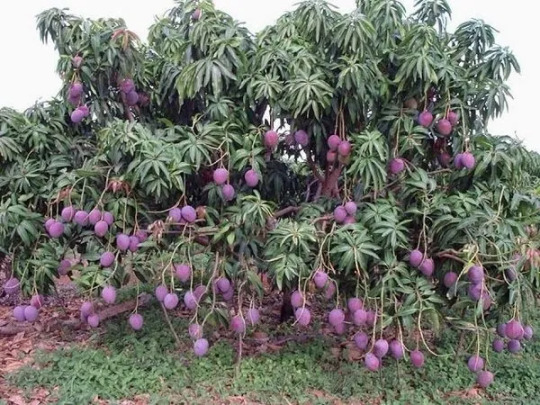

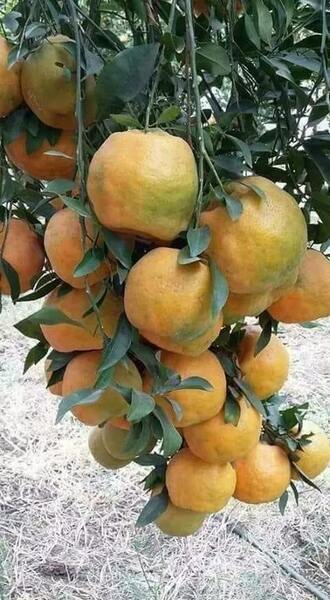
#https://jardimbr.blogspot.com/2024/07/protetor de caule para plantas e mudas.html#MudasFrutíferas#MudasDeFrutas#Pomar#Fruticultura#MudasDeLaranja#MudasDeMaçã#MudasDePêssego#MudasDeCoco#MudasDeJabuticaba#MudasDeAmora#MudasDeGoiaba#MudasDeCajá#MudasDeAcerola#MudasDeLichia#MudasDeFigo#MudasDeGuabiroba#MudasDePitaya#MudasDeNêspera#MudasDePinha#MudasDeAbacate#MudasDeUvaia#MudasDePitanga#MudasDeAtemoia#CultivoDeFrutas#FrutasFrescas#Jardinagem#JardimFrutífero#PlantasFrutíferas#CultivoDePlantas
1 note
·
View note
Text

Parmi les merveilles du printemps,
Quand les arbres se réveillent
La nature se pare de vert éclatant.
Mais il est un original, un sans-pareil :
Le cedrela.
Jeunes feuilles rose bonbon,
Sur le ciel de Paris,
Comme un air de Japon,
Instant de magie.
1 note
·
View note
Text
Spanish Cedar Vs Mahogany: The Ultimate Wood Showdown

Spanish Cedar is a superior wood choice for outdoor projects, while Mahogany is ideal for indoor applications. Spanish Cedar and Mahogany are two popular wood choices in the woodworking industry. While both offer exceptional qualities, they have distinct differences that make them suitable for specific projects. Spanish Cedar is a hardwood primarily used for outdoor applications due to its natural resistance to rot, decay, and insect infestation. It is known for its durability and ability to withstand harsh weather conditions. On the other hand, Mahogany is a versatile wood often chosen for indoor furniture and cabinetry. It is prized for its rich color, fine grain, and natural beauty. Additionally, Mahogany offers excellent workability and stability, making it a favorite among craftsmen. Understanding the characteristics of each wood type will help you make an informed decision when selecting the most appropriate material for your project.
Appearance And Physical Properties
When it comes to choosing the right wood for your furniture or woodworking projects, the appearance and physical properties are crucial factors to consider. In this article, we will be comparing the appearance and physical properties of Spanish Cedar and Mahogany, two popular and versatile wood types often used in the industry. Let's dive in and explore what sets them apart! Appearance Of Spanish Cedar Spanish Cedar, also known as Cedrela odorata, is a stunning wood with a distinct reddish-brown color that deepens with age. It boasts a straight and fine grain pattern that adds elegance to any piece. Its texture is typically medium to coarse, with a natural luster that gives it a rich and attractive appearance. Spanish Cedar also exhibits occasional knots and interlocking grain, enhancing its unique character. One of the most captivating features of Spanish Cedar is its aromatic scent. When freshly cut, it releases a pleasant fragrance that repels insects, making it an excellent choice for outdoor furniture or humid environments. Additionally, it has a highly fire-resistant nature, making it a safe option for certain applications.

Appearance Of Mahogany Mahogany, scientifically known as Swietenia macrophylla, is revered for its timeless beauty and versatility. It is famous for its stunning reddish-brown hue, often accented by dark streaks that add depth and character to the wood. The grain of Mahogany varies from straight to interlocked, lending an appealing aesthetic touch to the furniture and crafts made from it. With its medium to coarse texture, Mahogany showcases an enticing natural shimmer when properly finished. This wood species has a mildly interesting scent, which, while not as pronounced as Spanish Cedar, still adds a pleasant touch to the atmosphere. Comparison Of Physical Properties Let's take a closer look at the physical properties of Spanish Cedar versus Mahogany: Spanish Cedar Mahogany Density Light to medium-density Medium to high-density Hardness Soft to moderately hard Moderately hard Stability Relatively stable Moderately stable Workability Easy to work with Easy to work with Durability Good resistance to decay and insects High durability with natural resistance to rot and insects As shown in the table, Spanish Cedar is lighter and less dense than Mahogany. It possesses a softer to moderately hard nature, making it easier to work with, especially for intricate wood carving or turning projects. Moreover, it displays a greater resistance to decay and insects compared to Mahogany. On the other hand, Mahogany offers a higher density and hardness, resulting in furniture and structures that are incredibly sturdy and resilient. It also exhibits excellent durability, natural resistance to rot, and insect attacks from termites or beetles. Understanding the appearance and physical properties of Spanish Cedar and Mahogany gives you valuable insight into choosing the wood that best aligns with your project requirements. Both woods possess their unique charm, allowing you to create stunning works of art that stand the test of time.
Uses And Applications
Spanish Cedar and Mahogany are both widely used in various applications due to their excellent qualities. Spanish Cedar is known for its natural resistance to insects, making it a popular choice for humidors and outdoor projects. On the other hand, Mahogany is prized for its durability and beautiful grain, often found in furniture, cabinets, and musical instruments. Wood is not just a building material; it's an expression of craftsmanship and elegance. When it comes to selecting the right wood for your projects, two popular options stand out: Spanish Cedar and Mahogany. Each has its unique qualities and advantages. In this section, we will explore the common uses of Spanish Cedar and Mahogany, as well as compare their applications in different projects. Common Uses Of Spanish Cedar Spanish Cedar, scientifically known as Cedrela odorata, is cherished by woodworkers for its exceptional properties. Its distinct reddish-brown hue, straight grain, and fine texture make it a preferred choice for various applications. Here are some common uses of Spanish Cedar: - Exterior millwork: Spanish Cedar's natural resistance to decay and insects makes it ideal for outdoor applications such as siding, window frames, doors, and shutters. - Furniture: Its attractive appearance and workability make Spanish Cedar highly sought-after for crafting furniture pieces like cabinets, tables, chairs, and chests. - Cigar humidors: Spanish Cedar's aroma, low resin content, and ability to absorb moisture without warping make it a favored material for creating cigar humidors. - Interior finishings: Spanish Cedar's pleasing fragrance and resistance to mold and mildew make it a suitable choice for interior finishings like paneling, moldings, and trim work. Common Uses Of Mahogany Mahogany, scientifically known as Swietenia, is renowned for its rich, reddish-brown color and exceptional durability. Its strength, stability, and beauty have made it a classic wood choice for centuries. Here are some common uses of Mahogany: - Furniture: Mahogany's natural beauty and resistance to warping, swelling, and shrinking have made it a beloved material for crafting high-quality furniture, including tables, chairs, cabinets, and bed frames. - Veneer: Mahogany's attractive grain patterns make it a popular choice for creating veneers used in cabinetry, musical instruments, and decorative applications. - Boatbuilding: Due to its natural resistance to rot and its impressive strength-to-weight ratio, Mahogany is often utilized in boatbuilding, specifically for decks, hulls, and interior finishing. - Flooring: Mahogany's durability and warm, inviting color make it well-suited for flooring applications, adding elegance and sophistication to any space. Comparison Of Applications In Different Projects While both Spanish Cedar and Mahogany have their own unique charm and qualities, their applications may overlap in certain projects. Let's compare their applications across different woodworking projects: Spanish Cedar Mahogany Exterior Millwork ���️ ✔️ Furniture ✔️ ✔️ Cigar humidors ✔️ ✖️ Interior Finishings ✔️ ✖️ Veneer ✖️ ✔️ Boatbuilding ✖️ ✔️ Flooring ✖️ ✔️ As shown in the comparison table, Spanish Cedar and Mahogany both find their applications in exterior millwork and furniture-making. However, Spanish Cedar is preferred for cigar humidors and interior finishings, while Mahogany excels in veneer production, boatbuilding, and flooring. In conclusion, the choice between Spanish Cedar and Mahogany depends on the specific project requirements, desired aesthetics, and performance characteristics needed. Both woods offer exceptional quality and versatility, allowing artisans and craftsmen to bring their visions to life with grace and durability.
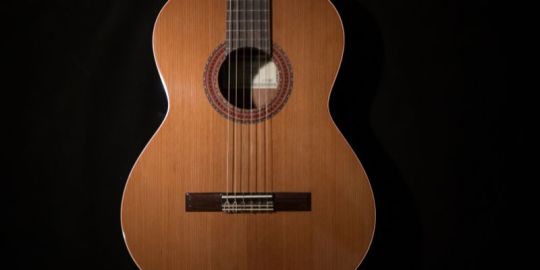
Frequently Asked Questions Of Spanish Cedar Vs Mahogany
What Is Spanish Cedar And Mahogany Wood Used For? Spanish Cedar is commonly used for manufacturing cabinets, humidors, and outdoor furniture. Mahogany wood is commonly used for furniture, boat building, and musical instruments. What Are The Differences Between Spanish Cedar And Mahogany? Spanish Cedar has a reddish-brown color, while Mahogany has a deeper reddish-brown hue. Spanish Cedar has a more pronounced aroma, while Mahogany has a subtle scent. Spanish Cedar is lighter in weight, while Mahogany is denser and heavier. Which Wood Is More Durable, Spanish Cedar Or Mahogany? Both Spanish Cedar and Mahogany are known for their durability. However, Mahogany is generally considered to be more durable and resistant to rot, decay, and pests. Can Spanish Cedar And Mahogany Be Used For Outdoor Projects? Yes, both Spanish Cedar and Mahogany can be used for outdoor projects. However, Spanish Cedar requires regular maintenance and protective finishes to preserve its appearance, while Mahogany is naturally more resistant to weathering and can be left untreated.
Conclusion
To summarize, when deciding between Spanish Cedar and Mahogany for your woodworking projects, it's important to consider their respective properties and advantages. Spanish Cedar's resistance to rot and insects makes it an excellent choice for outdoor applications, while Mahogany's durability and rich color make it ideal for furniture and interior projects. Ultimately, the decision will depend on your specific needs and preferences. Rio Grande Woods offers a wide selection of both Spanish Cedar and Mahogany to meet all your woodworking needs. Read the full article
0 notes
Text
Reid & Compañía, S. A. apoya a Medio Ambiente
Cevicos, Cotuí, RD- En el mes de la Reforestación, y a través de su Programa Somos Verde, colaboradores y colaboradoras de Reid & Compañía, S. A. se sumaron este 28 de octubre a la Jornada de Reforestación 2023 del Ministerio de Medio Ambiente, contribuyendo así con la siembra de 1,500 plantas de cedro americano, en Cevicos, Cotuí. El cedro americano (Cedrela odorata) es un árbol de la familia…

View On WordPress
0 notes
Video
tumblr
Para disminuir su explotación, Cedrela odorata L., se ha establecido en plantaciones forestales comerciales, programas de reforestación y más reciente en el programa federal Sembrando Vida con la finalidad de recuperarla. Sin embargo, antes de iniciar la producción de planta en vivero, se deben de identificar las procedencias de los sitios de colecta como el origen geográfico de las semillas (Zobel y Talbert, 1992), que es considerada como la fuente más importante para la producción de plantas forestales.
0 notes
Photo

In ancient China women believed that cedrela, a type of fragrant cedar, promoted hair growth. #hair #hairhistory #china #cedrela #cedartree New! Desert Botanicals Sonoranshine™️ Propylene Glycol Free Product Line, including➡️sulfate-free shampoo, rich conditioner, leave-in hair serum, and detangler. 🌱🌰🌵🏜 Vitamin nutrition including panthenol for hair rejuvenation, cactus and nut oils for shine, frizz protection and cuticle coating with healthy omega3 🌱🌰🌵🏜 Celebrating #hairstylists everywhere for their #artwork, #initiative and #independence! #calishair #californiahair #LAhair #orangecountystylist #sandiegostylist #sacramentostylist #sanfranciscostylist #sanjosestylist #longbeachstylist #irvinehair #santaanastylist #santaclarastylist #anaheimhair #sanjosehair #santamonicahair #santabarbarahair Everything we do is➡️➡️➡️ Paraben Free, Sulfate Free, Cruelty Free 🐰🐭 👨🔬Formulated in #scottsdale ⚗️ 🏜Proudly made in #arizona. 🌅 Learn more at➡️ www.dbotanicals.com https://www.instagram.com/p/CeWLEPRLEKo/?igshid=NGJjMDIxMWI=
#hair#hairhistory#china#cedrela#cedartree#hairstylists#artwork#initiative#independence#calishair#californiahair#lahair#orangecountystylist#sandiegostylist#sacramentostylist#sanfranciscostylist#sanjosestylist#longbeachstylist#irvinehair#santaanastylist#santaclarastylist#anaheimhair#sanjosehair#santamonicahair#santabarbarahair#scottsdale#arizona
0 notes
Photo

Inktober 03 - C de Cedrela. ¡Disponible para tatuar! contáctame. @verdeaguacomics
6 notes
·
View notes
Text

Serpent mask of Tlaloc (the Aztec god of rain and lightning), in the form of two intertwined and looped serpents worked in contrasting colours of turquoise mosaic.
Made of 'cedro' wood (Cedrela odorata) with pine resin adhesive. The teeth are made of conch (Strombus) shell and the resin adhesive in the mouth is coloured red with hematite.
The rattles of the serpent tails were originally gilded. They are moulded from a mixture of beeswax and pine resin; the same resin mixture coats the interior surface of the mask.
"Two serpents of blue and green turquoise mosaic entwine to form this stylised mask.
Their interwoven bodies create the prominent twisted nose and goggle eyes associated with Tlaloc, the god of rain. The eyebrows, which double as the two rattles from the serpents' tails, are made from pine resin and beeswax and would originally have been gilded. The teeth are depicted in white strombus shell.
Snakes copulate by intertwining, sometimes in a vertical position. In Mesoamerica, this act of procreation may have been observed and adapted, both visually and metaphorically, to symbolise the fertilizing rains sent by Tlaloc.
The striking green and blue colours of the mosaic evoke the waters and vegetation covering the earth's surface. On the mask's forehead an engraved mosaic tile in the shape of a bivalve shell may symbolise water, while the large green mosaic tile on the opposite snake perhaps represents vegetation, both aspects associated with Tlaloc. Mosaic representations of feathers flanking the face may have mimicked part of a larger headdress that once complemented the mask.
Open cavities in the eyes and suspension holes indicate that this mask may once have been worn. The priest who served Tlaloc in the Templo Mayor at Tenochtitlan was known as Quetzalcoatl Tlaloc Tlamacazqui, and may have worn a mask like this as part of his ritual attire. Another example of a Tlaloc wooden mask, painted in blue, has recently been excavated from the Templo Mayor (offering 102). It bears similar perforations and may have been worn by a deity impersonator."
The British Museum
279 notes
·
View notes
Photo
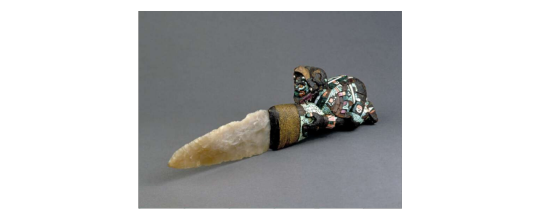

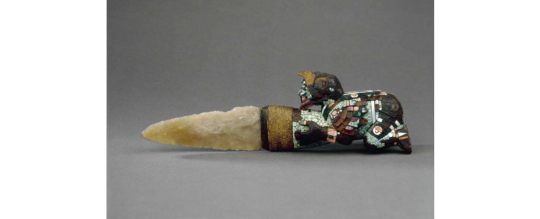



sacrificial knife; mosaic
Cultures/periods: Aztec or Mixtec
Production date: 1400-1521
Findspot: Mexico
Provenience unknown, possibly looted
Sacrificial knife, in the form of a crouching eagle warrior, with flint blade. Handle made of cedro wood (Cedrela odorata) and covered with mosaic made of turquoise, malachite and three types of shell: white conch (Strombus sp.), thorny oyster (Spondylus princeps) and mother-of-pearl (Pinctada mazatlanica). Pine resin is used as adhesive and decoratively as inlay. The blade hafting is bound with maguey fibre (Agave) and coated with Protium resin.
British Museum
77 notes
·
View notes
Photo













OLD POLISH FOUNDATIONS by betty Finke
“Since my old Polish stallions in the circus proved unexpectedly popular, here are some more old Polish gems.
Ostenfelde was an Arabian farm I visited on a regular basis from its beginnings in the mid-1970s to its dissolution some 20 years later. In its heyday during the 1980s/90s, Ostenfelde was the largest pure Polish Arabian stud in Europe outside of Poland and was known as ‘Little Janow’. It had two herds of broodmares, one grey and one bay, and its annual foal presentations (with up to 30 foals) were major events in the area.
Most of the foundation mares came from the Polish auctions, but in the 1970s/80s the American breeders were paying huge prices and buying all the best horses. Ostenfelde started by buying what they could afford, which were the mares the American buyers weren’t interested in, so they were not what you’d call pretty. But they had the bloodlines and there was nowhere to go but up. With a little help from some really good stallions – especially Euben, full brother to Eukaliptus – the horses improved with each successive generation and some better mares from Poland arrived as well. Ostenfelde was a model stud farm with state-of-the-art facilities, and its owners Wolfgang and Ingeburg Thörner were the nicest people you could hope to meet. They bred wonderful all around useful as well as beautiful horses. I spent many happy hours there over the years and eventually got to name a lot of their foals. Because of the owner’s declining health and there being no one to carry on, the stud was disbanded just before the turn of the century.
So here are photos of the foundation mares, as far as I have them, in memory of one of my favourite farms of the past (and also of my friend Karin Freutel, who appears in some of the photos showing the horses and who died far too young).”
Pictured are Arabia *1974 (Mors x Arabella by Adonah), Aragonia *1968 (Almifar x Arba by Comet), Aretuza *1963 (Ferrum x Arkadia by Wielki Szlem), Cedrzana *1973 (Celebes x Cedrela by Doktryner), Cerania *1980 (El Paso x Ceremonia by Celebes), Cetynia *1981 (Wist x Cerisola by Carrador),with her 1994 filly Celtia by Euben, Czarka *1966 (Mir Said x Czarowna by Comet), Dializa *1968 (El Azrak x Diamira by Mir Said), Diamante *1975 (Celebes x Dializa by El Azrak) with her 1988 filly Dialista by Czersk, Dimini *1967 (El Azrak x Dimatra by Wielki Szlem), Dymarka *1970 (Bajdak x Druchna by Rozmaryn), Ekipa *1977 (Eufrat x Ekstaza by Celebes) with her 1994 filly Esiena by Euben, and Eni *1981 (Aloes x Euforia by Bandos)with her 1993 filly Enina by Cenzor.
#arabians#polish arabians#hotblood horses#horses#equines#click the link to the original post for even more photos
23 notes
·
View notes
Photo
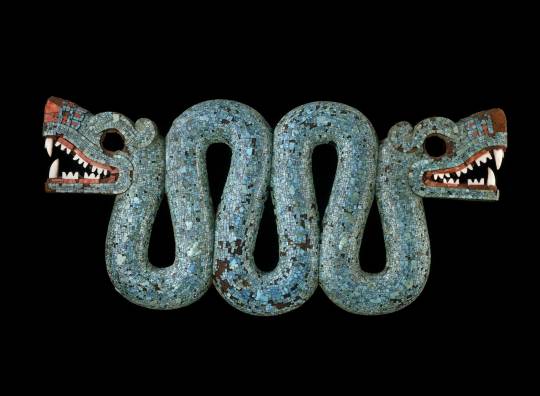
Aztecs (Mexica) | Serpent mosaic An icon of Aztec art, this striking object was probably worn on ceremonial occasions as a pectoral (an ornament worn on the chest). It is carved from cedar wood (Cedrela odorata) that is hollowed from the back and covered with turquoise mosaic. Serpent imagery occurs throughout the iconography of Mesoamerica. The serpent forms part of several Aztec/Mexica deities, including Quetzalcoatl (Feathered Serpent), Xiuhcoatl (Fire Serpent), Mixcoatl (Cloud Serpent) and Coatlicue (Serpent Skirt), the mother of creator god, Huitzilopochtli. The periodic shedding of snakes’ skin contributed to their being associated with renewal and transformation. The ability of many species to move freely between water, earth and the forest canopy produced the metaphor whereby snakes were intermediaries between the different layers of the cosmos (underworld, earth and sky). The bright red details around the nose and mouth of both serpent heads are made from (spondylus) thorny oyster. The resin adhesive inside the mouths was coloured bright red with hematite and Strombus (conch) shell was used for the white teeth. Beeswax has been adhered to the edges of the empty eye sockets, which were probably originally inlaid, perhaps with iron pyrites. The reverse of the body is undecorated, although the surface may originally have been gilded, but the heads are worked in mosaic on both sides. Resins from pine and copal trees were used as adhesives for the mosaic.
21 notes
·
View notes